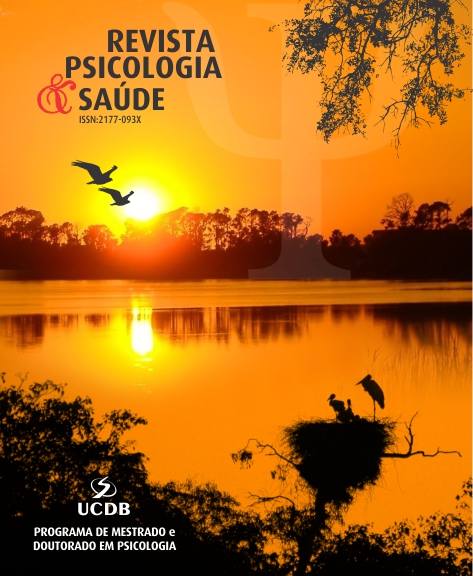Sexual Violence against Children and Adolescents: Implicit Theory
DOI:
https://doi.org/10.20435/pssa.v14i4.1811Keywords:
sexual abuse, sex offenses, harassment, violence against children and adolescents, implicit theories, sex offenderAbstract
The aim of this text is to identify the implicit theories about masculinity and the child/adolescent victim, in the contents of speeches from adult male sexual offenders. In sexual violence, the sexual offender assumes properties of their victims based on their own mental representations. This is a documental research carried out in an institution that treats adult sexual offenders, based on the records of two group interventions that took place in 2018 and 2019. The results were organized and discussed in topics that emphasized: the expression of masculinity and the relationship with the woman and the child/adolescent. It sought to give visibility to the construction of beliefs and impositions of thought that are produced in social and family life, and that give greater power and domination to man. These meanings indicate the male gender as the center of relationships, and the female gender submitted and dominated.
References
Beech, A. R., & Ward, T. (2004). The integration of etiology and risk in sexual offenders: A theoretical framework. Aggression and Violent Behavior, 10, 31–63. https://doi.org/10.1016/j.avb.2003.08.002 DOI: https://doi.org/10.1016/j.avb.2003.08.002
Braun, V., & Clarke, V. (2019). One size fits all? What counts as quality practices in (reflexive) thematic analysis? Qualitative Research in Psychology, 18(3), 328–352. https://doi.org/10.1080/14780887.2020.1769238 DOI: https://doi.org/10.1080/14780887.2020.1769238
Cechinel, A., Fontana, S. A. P., Giustina, K. P. D., Pereira, A. S., & Prado, S. S. (2016). Estudo/Análise Documental: Uma revisão teórica e metodológica. Criar Educação, 5(1), s.p. http://periodicos.unesc.net/criaredu/article/view/2446/2324 DOI: https://doi.org/10.18616/ce.v5i1.2446
Christensen, L. (2017). Child Sexual Offenders: The psychology of offending. In W. Petherick, & G. Sinnamon (Orgs.), The Psychology of Criminal and Antisocial Behavior: Victim and Offender Perspectives (pp. 439–458). Elsevier. DOI: https://doi.org/10.1016/B978-0-12-809287-3.00015-8
Clayton, E., Jones, C., Brown, J., & Taylor, J. (2018). The aetiology of child sexual abuse: A critical review of the empirical evidence. Child Abuse Review, 27(3), 181–197. https://doi.org/10.1002/car.2517 DOI: https://doi.org/10.1002/car.2517
Connolly, M. (2004). Developmental Trajectories and Sexual Offending: An Analysis of the Pathways Model. Qualitative Social Work, 3(1), 39–59. https://doi.org/10.1177/1473325004041131 DOI: https://doi.org/10.1177/1473325004041131
Cossins, A., & Plummer, M. (2018). Masculinity and sexual abuse: Explaining the transition from victim to offender. Men and masculinities, 21(2), 163–188. https://doi.org/10.1177/1097184X16652655 DOI: https://doi.org/10.1177/1097184X16652655
Costa, L. F., Penso, M. A., Conceição, M. I. G., & Montenegro, N. M. S. (2018a). Abuso sexual com vítimas do sexo masculino: Revitimização e polivitimização. In L. F. Habigzang, P. I. C. Gomide, & G. M. da Rocha (Eds.), Psicologia Forense: Temas e Práticas (pp. 71–87). Juruá.
Costa, L. P., Cavalcante, L. C., & Reis, D. C. (2018b). Autores de agressão sexual em contextos intra e extrafamiliar: Revisão da literatura. Mudanças-Psicologia da Saúde, 26(2), 61–69. http://dx.doi.org/10.15603/2176-1019/mud.v26n2p61-69 DOI: https://doi.org/10.15603/2176-1019/mud.v26n2p61-69
Dangerfield, B., Ildeniz, G., & Ó Ciardha, C. (2020). Theories that explain the sexual abuse of children. In J. Prouxl, F. Cortoni, L. A. Craig, & E. Letourneau (Eds.), The Wiley Handbook of What Works with sexual offenders: Contemporary Perspectives in Theory, Assessment, Treatment, and Prevention. John Wiley & Sons. https://doi.org/10.1002/9781119439325.ch2 DOI: https://doi.org/10.1002/9781119439325.ch2
Debona, T. L., Teixeira, A. N., Lima, D. J. M., Neto, M. L., & Gontijo, R. C. (2018). O outro lado da história – Um olhar sistêmico sobre os ofensores sexuais intrafamiliares. Revista Interdisciplinar Pensamento Científico, 4(3), 130–138. http://dx.doi.org/10.20951/2446-6778/v4n3a13
Depraetere, J., Vandeviver, C., Beken, T. V., & Keygnaert, I. (2018). Big boys don’t cry: A critical interpretive synthesis of male sexual victimization. Trauma, Violence, & Abuse, 00(0), 1–20. http://dx.doi.org/10.1177/1524838018816979 DOI: https://doi.org/10.1177/1524838018816979
Edley, N. (2017). Men and Masculinity: The Basics. Routledge.
Hillis, S., Mercy, J., Amobi, A., & Kress, H (2016). Global Prevalence of Past-Year Violence Against Children: A Systematic Review and Minimun Estimates. Pediatrics, 137(3), e20154079. https://doi.org/10.1542/peds.2015-4079 DOI: https://doi.org/10.1542/peds.2015-4079
Hyde, S. J., & DeLamater, J. D. (2017). Understanding Human Sexuality (13ª ed.). McGraw-Hill Education.
Javaid, A. (2018). Male rape, masculinities, and sexualities. International Journal of Law, Crime and Justice, 52, 199–210. https://doi.org/10.1016/j.ijlcj.2017.12.003 DOI: https://doi.org/10.1016/j.ijlcj.2017.12.003
Lordan, T. (2020). Sexual Consent perceptions of child sex offenders who experienced childhood sexual abuse [Dissertation, Walden University]. https://www.proquest.com/openview/cc6ba0a1e1608e70a79b4b8b355ef78c/1?pq-origsite=gscholar&cbl=18750&diss=y
Marshall, W. L. (2018). A brief history of psychological theory, research, and treatment with adult male sex offenders. Current Psychiatry Reports, 20(8), 1–8. https://doi.org/10.1007/s11920-018-0920-0 DOI: https://doi.org/10.1007/s11920-018-0920-0
McKillop, N. (2019). Understanding the nature and dimensions of child sexual abuse to inform its prevention. In B. India, R. Yolande, & W. Patherick (Eds.), Child Abuse and Neglect (pp. 241–259). Academic Press. DOI: https://doi.org/10.1016/B978-0-12-815344-4.00013-1
McPhail, B. A. (2015). Feminist framework plus: Knitting feminist theories of rape etiology into a comprehensive model. Trauma, Violence & Abuse, 17(3), 314–329. https://doi.org/10.1177/1524838015584367 DOI: https://doi.org/10.1177/1524838015584367
Meneses, F. F. F., Ströher, L. M. C., Setubal, C. B., dos Santos Wolff, L., & Costa, L. F. (2016). Intervenção psicossocial com o adulto autor de violência sexual intrafamiliar contra crianças e adolescentes. Contextos Clínicos, 9(1), 98–108. https://doi.org/10.4013/ctc.2016.91.08 DOI: https://doi.org/10.4013/ctc.2016.91.08
Ministério da Saúde (2017). Portaria nº 344, de 1 de fevereiro de 2017. Dispõe sobre o preenchimento do quesito raça/cor nos formulários dos sistemas de informação em saúde. https://bvsms.saude.gov.br/bvs/saudelegis/gm/2017/prt0344_01_02_2017.html
Ministério da Saúde (2018). Análise epidemiológica da violência sexual contra crianças e adolescentes no Brasil nos anos de 2011 a 2017. Boletim Epidemiológico, 49(27), 1–17. https://portaldeboaspraticas.iff.fiocruz.br/wp-content/uploads/2019/07/2018-024.pdf
Nogueira, R. N., Costa, L. F., Passarela, C. D. F. T., & Setubal, C. B. (2020). Apreensão do sofrimento do adulto ofensor sexual em intervenção psicossocial: Uma etnografia. Revista Subjetividades, 20(1), 12–03. https://doi.org/10.5020/23590777.rs.v20i1.e9713 DOI: https://doi.org/10.5020/23590777.rs.v20i1.e9713
Ó Ciardha, C., Gannon, T., & Ward, T (2016). The Cognitive distortions of child sexual abusers. In D. P. Boer (ed.), The Wiley Handbook on the Theories, and Treatment of Sexual offending (vol. 1, pp. 207–222). John Wiley & Sons. DOI: https://doi.org/10.1002/9781118574003.wattso010
Oliveira, I. R. S., Rocha, L. L. S., Santos, V. É. S., Avelino, L. F. L., & Targino, G. C. (2020). O Simulacro da masculinidade como arquétipo cultural da objetificação do corpo feminino: Da virilidade ao estupro. Revista Brasileira de Direito e Gestão Pública, 8(2), 332–344. https://www.editoraverde.org/gvaa.com.br/revista/index.php/RDGP/article/view/7905
Passarela, C. D. F. T., Setubal, C. B., Meneses, F. F. F., Wolff, L. S., Costa, L. F., Ströher, L. M. C., & Vieira, T. B. (2017). Intervenção psicossocial com adulto ofensor sexual: A experiência do Alecrim (PAV/SES/GDF). Coletânea de Textos, Caderno Temático 3, 73–76.
Penso, M. A., Conceição, M. I., Costa, L. F., Meneses, F. F. F., Stroher, M. L. C., Setubal, C. B., & Wolff, L. S. (2016). Perfil do ofensor sexual intrafamiliar adulto atendido em uma instituição de saúde. L. F. Habigzang, L. C. A. Williams, & P. I. Gomide (Eds.), A Outra Face da Violência: Agressores em Múltiplos Contextos (pp. 67–80). Juruá.
Presidência da República (2009). Lei nº 12.015, de 7 de agosto de 2009. Dispõe sobre os crimes hediondos. http://www.planalto.gov.br/ccivil_03/_Ato2007-2010/2009/Lei/L12015.htm
Presidência da República. (1940). Decreto-Lei nº 2.848, de 7 de dezembro de 1940. Código Penal Brasileiro. Diário Oficial da União. http://www.planalto.gov.br/ccivil_03/decreto-lei/Del2848.htm
Presidência da República. (1990). Lei nº 8069, de 13 de julho de 1990. Dispõe sobre o Estatuto da Criança e do Adolescente e dá outras providências. http://www.planalto.gov.br/ccivil_03/leis/L8069.htm
Said, A. P. & Costa, L. F. (2019). Ofensores sexuais de vítimas do sexo masculino (notificações do Distrito Federal, Brasil). Acta Psiquiatrica y Psicologia, 65(1), 44–56.
Secretaria de Saúde do Distrito Federal. (2020). Informe Epidemiológico Quadrimestral de Violência Interpessoal e Autoprovocada no Distrito Federal. http://www.saude.df.gov.br/wp-conteudo/uploads/2018/05/BOLETIM-2%C2%BA-QUADRIMESTRE-2020.pdf
Secretaria Nacional dos Direitos da Criança e do Adolescente (2013). Plano Nacional de Enfrentamento da Violência Sexual contra Crianças e Adolescentes. http://www.crianca.mppr.mp.br/arquivos/File/publi/sedh/08_2013_pnevsca.pdf
Seto, M. C. (2012). Is Pedophilia a Sexual Orientation? Archives of Sexual Behavior, 41, 231–236. https://doi.org/10.1007/s10508-011-9882-6 DOI: https://doi.org/10.1007/s10508-011-9882-6
Setubal., C. B., Wolff, L. S., & Costa, L. F. (2020). Pensamentos de risco de um adulto autor de violência sexual. Revista Psicologia e Saúde, 12(2), 105–122. http://dx.doi.org/10.20435/pssa.v0i0.897 DOI: https://doi.org/10.20435/pssa.v0i0.897
Sullivan, J., & Sheehan, V. (2016). What motivates sexual abusers of children? A qualitative examination of the spiral of sexual abuse. Aggression and violent behavior, 30, 76–87. https://doi.org/10.1016/j.avb.2016.06.015 DOI: https://doi.org/10.1016/j.avb.2016.06.015
Szumski, F., Bartels, R. M., Beech, A. R., & Fisher, D. (2018). Distorted cognition related to male sexual offending: The multi-mechanism theory of cognitive distortions (MMT-CD). Aggression and Violent Behavior, 39, 139–151. https://doi.org/10.1016/j.avb.2018.02.001 DOI: https://doi.org/10.1016/j.avb.2018.02.001
Ward, T. (2000). Sex offenders’ cognitive distortions as implicit theories. Aggression and Violent Behavior, 5(5), 491–507. https://doi.org/10.1016/S1359-1789(98)00036-6 DOI: https://doi.org/10.1016/S1359-1789(98)00036-6
Ward, T., & Beech, A. R. (2016). The Integrated Theory of Sexual Offending-Revised. The Wiley Handbook on the Theories, Assessment and Treatment of Sexual Offending, pp.123–137. https://doi.org/10.1002/9781118574003.wattso006 DOI: https://doi.org/10.1002/9781118574003.wattso006
Ward, T., Gannon, T., & Keown, K. (2006). Beliefs, values, and actions: The Judgment Model of Cognitive Distortions in Sexual Offenders. Aggression and Violent Behavior, 11(4), 323–340. https://doi.org/10.1016/j.avb.2005.10.003 DOI: https://doi.org/10.1016/j.avb.2005.10.003
World Health Organization. (2017). Responding to children and adolescents who have been sexually abused. https://apps.who.int/iris/bitstream/handle/10665/259270/9789241550147-eng.pdf?sequence=1
Yin, R. (2014). Estudo de caso: Planejamento e métodos. Bookman
Zanello, V. (2018). Saúde mental, gênero e dispositivos: Cultura e processos de subjetivação. Appris.
Published
How to Cite
Issue
Section
License

This work is licensed under a Creative Commons Attribution 4.0 International License.
The articles published on journal Psicologia e Saúde holds the copyrights of all texts published by it. Due to that, there is a demand for a letter of copyright cession (see Appreciation). The full reproduction of any article of this Journal in other publications, by any means, requires a written authorization of the Editorial Board. Partial reproductions of articles (abstracts, more than 500 words of text, tables, pictures and other illustrations, sound files) should have the written permission of the Editorial Board and the Authors.












